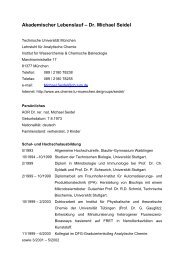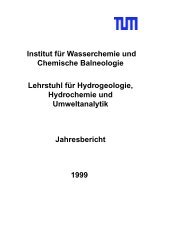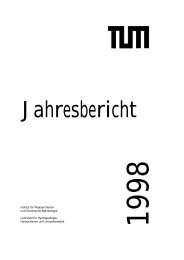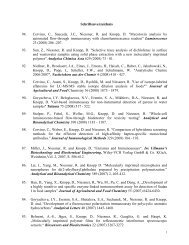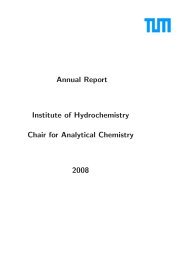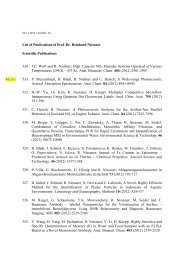IWC Annual Report 2003 - Institut für Wasserchemie und chemische ...
IWC Annual Report 2003 - Institut für Wasserchemie und chemische ...
IWC Annual Report 2003 - Institut für Wasserchemie und chemische ...
Create successful ePaper yourself
Turn your PDF publications into a flip-book with our unique Google optimized e-Paper software.
1.4 Laser Spectroscopy I<br />
1.4.1 Microanalysis Using the Laser-Induced Plasma Spectroscopy (LIPS) and<br />
VUV-Echelle Spectrograph<br />
F<strong>und</strong>ing: DFG Pa 716/2-1<br />
Cooperation: ISAS, Berlin<br />
Since the early days of laser spectroscopy, laser ablation in combination with optical<br />
emission spectroscopy or mass spectrometry has been utilized for spatially-resolved<br />
analysis. Laser-induced plasma spectroscopy (LIPS, or laser induced breakdown spectroscopy,<br />
LIBS) has been recognized early as potential tool for microanalysis. In<br />
contrast to other techniques), LIPS offers the prospect of a fast and highly automated<br />
at-line analysis without or only minor sample preparation.<br />
The objective of this work was to extend the range of<br />
elements for microanalysis by LIPS, via observation of<br />
atomic emission in the VUV (120-200 nm) range. This<br />
permits not only a multielement analysis of metals, but<br />
also access to emission lines of metalloids such as S, P,<br />
N,O, C, and As. Two experimental set-ups for VUV-LIPS<br />
were realized: A set-up for bulk analysis based on conventional<br />
Czerny-Turner monochromator and a new echelle<br />
spectrograph. With the latter a new set-up for microanalysis<br />
by laser-induced plasma spectroscopy (LIPS) in the<br />
VUV range was designed. The system features an integrated<br />
ablation and detection module with a VUV echelle<br />
which permits a full spectral coverage between 150 and<br />
300 nm with a resolving power between 11000 - 15000.<br />
At present, the ablation module permits a microanalysis<br />
with a crater size of 25 µm and a nominal depth resolution with an ablation rate<br />
of 150 nm per pulse. The VUV performance was demonstrated for bulk analysis of<br />
steel, detection limits for sulphur, carbon, and phosphorus were in the lower mg/kg<br />
range. The VUV scanning and mapping performance for heterogeneous matrices was<br />
illustrated for mineral bottom ash samples from a waste incineration process.<br />
(Igor Radivojevic)<br />
1.4.2 Investigation of the Colloidal Transport in Biological Sewage Plants Using<br />
AF 4 and ICP-MS<br />
F<strong>und</strong>ing: DFG Pa716/4-1<br />
Cooperation: <strong>Institut</strong>e of Water Quality Control and Waste Management, TUM (Prof.<br />
Wilderer)<br />
The goals of this project are the investigation of interactions of artificial tracer colloids<br />
with biofilms in laboratory reactors and technical plants, and the characterization of<br />
hydrocolloids in biological sewage plants. Several spherical lanthanoide(III)phosphate<br />
colloids with different size distribution have been synthesized by slow increase of pH in<br />
solutions which contain soluble rare earth metal salts and phosphoric acid. The best<br />
results have been received with Thulium, which will be used as tracer colloid in the<br />
future. At present experiments at a biofilm reactor containing a bacteria strain, which<br />
is able to degrade 2,4-D are carried out to receive informations about interactions of<br />
tracer colloids with biofilms.<br />
17



